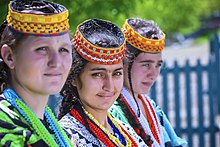
Back قبيلة الكيلاش Arabic قبيلة الكيلاش ARZ Kalaşlar Azerbaijani کالاشلار AZB Калаши Bulgarian কালাশ জনগোষ্ঠী Bengali/Bangla Kalash Catalan Kalašové Czech Калашсем CV Kalasha (Chitral) German
 Kalash girls photographed in April 2016 | |
| Total population | |
|---|---|
| c. 3,800[1] | |
| Regions with significant populations | |
| Kalasha Valleys, Chitral District, Pakistan | |
| Languages | |
| Kalasha, Khowar | |
| Religion | |
| Ancient Hinduism[2][a][3]/Animism,[4][5][6] Islam[7] | |
| Related ethnic groups | |
| Nuristanis, other Indo-Aryan peoples |
The Kalash (Kalasha: کالؕاشؕا, romanised: Kaḷaṣa, Devanagari: कळष), or Kalasha, are an Indo-Aryan[8][b] indigenous people residing in the Chitral District of the Khyber-Pakhtunkhwa province of Pakistan.
They are considered unique among the people of Pakistan.[9][10][11] They are also considered to be Pakistan's smallest ethnoreligious group,[12] and traditionally practice what authors characterise as a form of animism.[13][4][5][c][6][d] During the mid-20th century an attempt was made to force a few Kalasha villages in Pakistan to convert to Islam, but the people fought the conversion and, once official pressure was removed, the vast majority resumed the practice of their own religion.[10] Nevertheless, some Kalasha have since converted to Islam, despite being shunned afterward by their community for having done so.[7][14]
The term is used to refer to many distinct people including the Väi, the Čima-nišei, the Vântä, plus the Ashkun- and Tregami-speakers.[10] The Kalash are considered to be an indigenous people of Asia, with their ancestors migrating to Chitral valley from another location possibly further south,[9][15] which the Kalash call "Tsiyam" in their folk songs and epics.[16]
They claim to descend from the armies of Alexander who were left behind from his armed campaign, though no evidence exists for him to have passed the area.[17][18][e] They are also considered by some to have been descendants of Gandhari people.[19]
The neighbouring Nuristani people of the adjacent Nuristan (historically known as Kafiristan) province of Afghanistan once had the same culture and practised a faith very similar to that of the Kalash, differing in a few minor particulars.[20][21]
The first historically recorded Islamic invasions of their lands were by the Ghaznavids in the 11th century[22] while they themselves are first attested in 1339 during Timur's invasions.[19] Nuristan had been forcibly converted to Islam in 1895–96, although some evidence has shown the people continued to practice their customs.[23] The Kalash of Chitral have maintained their own separate cultural traditions.[24]
- ^ "The last of the Kalasha". 24 February 2019.
- ^ a b West, Barbara A. (19 May 2010). Encyclopedia of the Peoples of Asia and Oceania. Infobase Publishing. p. 357. ISBN 9781438119137.
- ^ Bezhan, Frud (19 April 2017). "Pakistan's forgotten pagans get their due". Radio Free Europe/Radio Liberty. Retrieved 11 July 2017.
About half of the Kalash practice a form of ancient Hinduism infused with old pagan and animist beliefs.
- ^ a b Searle, Mike (28 March 2013). Colliding Continents: A geological exploration of the Himalaya, Karakoram, and Tibet. OUP Oxford. ISBN 978-0-19-165249-3.
- ^ a b c Camerapix (1998). Spectrum Guide to Pakistan. Interlink Books. ISBN 978-1-56656-240-9.
- ^ a b c Sheehan, Sean (October 1993). Pakistan. Marshall Cavendish. ISBN 978-1-85435-583-6.
- ^ a b Cite error: The named reference
Ahmed-1986was invoked but never defined (see the help page). - ^ a b West, Barbara A. (19 May 2010). Encyclopedia of the Peoples of Asia and Oceania. Infobase Publishing. p. 357. ISBN 9781438119137.
- ^ a b "The Kalash – Protection and Conservation of an Endangered Minority in the Hindukush Mountain Belt of Chitral, Northern Pakistan" (PDF). Archived from the original (PDF) on 7 July 2007.
- ^ a b c "Richard Strand's Nuristân Site: The Kalasha of Kalashüm". www.nuristan.info. Retrieved 31 December 2022.
- ^ Augusto S. Cacopardo. Pagan Christmas: Winter Feasts of the Kalasha of the Hindu Kush. p.28.
- ^ "'Earthquake was Allah's wrath for Kalash community's immoral ways'". The Express Tribune. 10 November 2015. Retrieved 11 November 2015.
- ^ "The Kalash: Pakistan's last animist tribe". Atalayar. 29 March 2021. Retrieved 31 December 2022.
- ^ "Tribe of Kalash: The Last Kafir". Global Human Rights Defence. 1 March 2021. Archived from the original on 22 April 2021. Retrieved 11 April 2021.
- ^ Nicolaisen, Johannes; Yde, Jens (1963). Folk: dansk etnografisk tidsskrift. Dansk etnografisk forening.
- ^ East and West. Istituto italiano per il Medio ed Estremo Oriente. 1992.
- ^ Shah, Danial (29 September 2012). "In the land of infidels". DAWN.COM. Retrieved 16 March 2023.
- ^ a b Strand, R. "The kalaṣa of kalaṣüm Strand". nuristan.info.
- ^ a b Cite error: The named reference
Ludwigwas invoked but never defined (see the help page). - ^ Saxena, Anju (12 May 2011). Himalayan Languages: Past and Present. Walter de Gruyter. p. 72. ISBN 9783110898873.
- ^ South Asian Folklore: An Encyclopedia : Afghanistan, Bangladesh, India, Nepal, Pakistan, Sri Lanka. Taylor & Francis. 2003. p. 318. ISBN 9780415939195.
- ^ Pagan Christmas: Winter Feasts of the Kalasha of the Hindu Kush, By Augusto S. Cacopardo
- ^ Klimberg, Max (1 October 2004). "NURISTAN". Encyclopædia Iranica (Online ed.). United States: Columbia University.
- ^ Newby, Eric. A Short Walk in the Hindu Kush. 2008. ISBN 1741795281
Cite error: There are <ref group=lower-alpha> tags or {{efn}} templates on this page, but the references will not show without a {{reflist|group=lower-alpha}} template or {{notelist}} template (see the help page).
© MMXXIII Rich X Search. We shall prevail. All rights reserved. Rich X Search